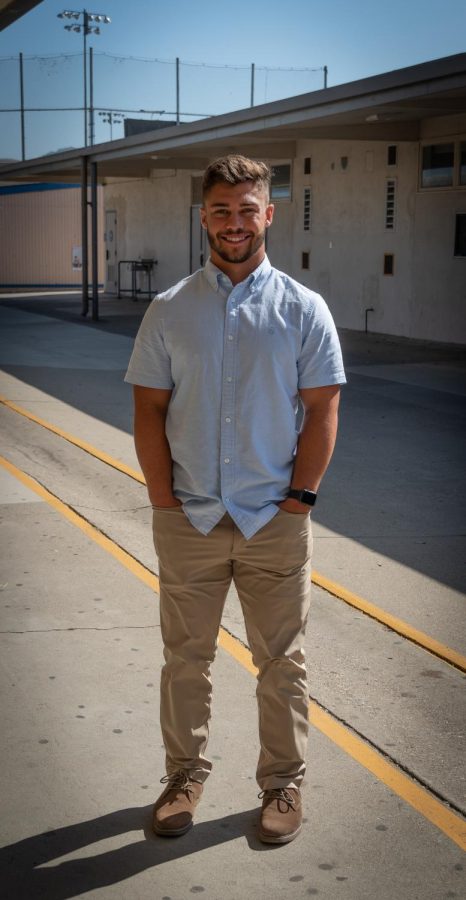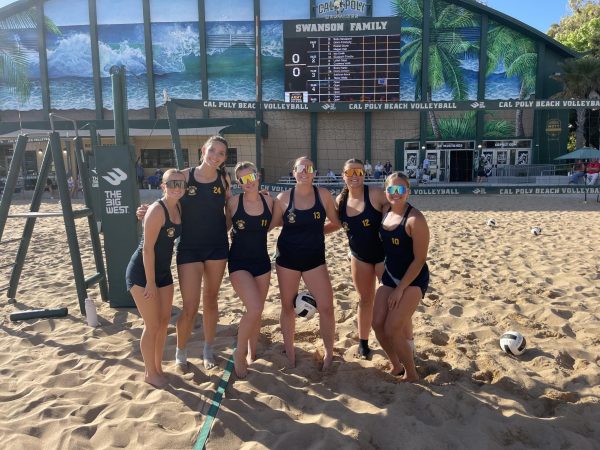Caleb Tomasin perseveres through injury
Senior shows mental and physical strength through adversity
(Republished from November 2019)
Caleb Tomasin took the football and ran. He was so focused that he could barely hear the crowd. He kept running. The adrenaline pumping through his veins silenced the strain of his muscles, and he kept running. It was only after the play was over that he realized he had just rushed 80 yards down the field in a single run. Not just any 80 yards—80 yards against some of the best varsity football players the central coast has to offer, during a varsity game. He was playing the best he ever had. He had over 200 yards of rushing that game, and it was only the third quarter. The coach immediately called the same play again.
Caleb Tomasin took the football and ran. The crowd’s cheering was once again lost. This time he didn’t make it 80 yards down the field, not because of the fact that there weren’t 80 more yards left on the field, but because of a force equally as powerful as him. He was slammed by an opponent.
The play wasn’t just over for AGHS’s starting Varsity running back and team captain. The whole game was. He realized this the instant after the impact when his knee inverted and the popping sound it made resonated throughout his entire body.
“Someone came and hit me on the side, and my knee just inverted. As soon as it happened, I heard a pop and I knew it was pretty bad. I kinda just like threw the ball up ‘cause the pain and everything was just overwhelming, it instantly clicked and I just hopped off the field before anyone knew what was going on. I just listened to my body, and I just knew it wasn’t supposed to make that noise.”
The Grade Two MCL tear, paired with the Grade One PCL tear, was estimated to take four weeks to heal. In early October, Caleb’s leg was encased in a brace to minimize the stress on the damaged area.
The MCL, or Medial Collateral Ligament, is located on the inner part of the knee, but outside of the joint itself. All ligaments, by definition, hold bones together and add strength and stability to a joint (Healthline). In particular, the MCL connects the tibia to the femur. In normie-speak, it connects the shinbone to the thigh bone. A Grade Two tear means that the ligament is badly damaged but not totally snapped. The PCL, or Posterior Cruciate Ligament, also connects the same two bones but in a different part of the knee. A Grade One tear of the PCL means a lesser amount of tear than a Grade Two, but still constitutes at least two weeks of recovery for just this one injury.
“I’m not gonna rush anything though. If my knee doesn’t feel like it’s stable and I can’t plant on it, then there’s no point in me going back and risking re-injury. I’d have to say two weeks from today [October 2nd, 2019] should be a great estimate.”
While Caleb Tomasin’s injuries would serve as ample reason for the average player to quit football, Tomasin is no ordinary man. His face paled as he imagined a second more of life without his favorite sport.
“It takes up a lot of your time, and you don’t have much time for social activities outside of the group that you’re with, but the friendships and bonds that I’ve formed with the guys on the team is priceless. I wouldn’t trade that for anything in the world, and it’s hard. Like you’re waking up early every morning, like at six o’clock we have practice, even in summer. But the character I think that builds is unparalleled for sure. You form a strict regimen, and yeah, I don’t have any regrets.”
Football seems to be the Tomasin family sport, or at least it’s one of them. Tomasin has also played baseball, basketball, as well as track and field, and he currently plays football and rugby at a high level.
“My dad played [football] in college and all throughout his life, and my two older brothers both played when they got into middle school, so by the time I was able to play, it was just a big part of our lives, and so I just kinda got introduced to the idea. From the time I could walk, I had a football in my hand.”
Tomasin hopes to play football in college, and his mark is set on Boise State University or San Diego State. If he can’t play football in college, his next plan is rugby. He hopes to major in kinesiology.
“My dad is a physical therapist, and I’ve been introduced to that field my whole life and it’s something that, cuz even when my sports career is over, I want to stay involved with young athletes and try to get them back onto the field. Especially having suffered an injury, I know what it’s like to have that part of your life just stripped away from you, so if I could be involved in the recovery process, both physically and mentally for young kids, I would love to be doing that.”
With such ambitious goals in mind, and with football taking up a large chunk of his time, Tomasin has become excellent at time management.
“I think we all fall into the trap of procrastination, but I just think of what [else] I could be doing… It’s just following a pattern and being consistent with what you do… Also just knowing your limits, like if you can’t hang out with your friends because you have homework, like it sucks in the moment but there’s always opportunities to socialize and you don’t get to make up all these tests that you should be studying for.”
Tomasin offers his encouragement to anyone who is considering trying football, or any other sport.
“I’d say if you have any interest in playing sports—football in particular—go for it. You never know until you try it, and it is a big time commitment, but the bonds and relations, and the mental toughness you get from football is unparalleled by anything else I’ve experienced. But be smart with yourself. If you have to have a job, like talk to your coach and just have good time management skills. I think that’s the biggest key in being a student athlete. Just know what you have to get done in order to be what you want to be.”
Caleb Tomasin will be back on the field by the time of printing. He’ll be scoring touchdowns, plowing through opponents, rushing dozens of yards per play, leading his team both on and off the field, succeeding in school, and achieving his goals.

My name is Hudson Reynolds and I am a senior at AGHS. I always wanted to be a part of a student-run newspaper or radio and I am so glad that I got the...





!["Coaching golf at AGHS is my chance to be a part of [a bigger community], and I am blessed and humbled by the opportunity and the responsibility that comes with it," Schiro said.](https://aghseagletimes.com/wp-content/uploads/2025/05/IMG_5361-600x383.jpg)
